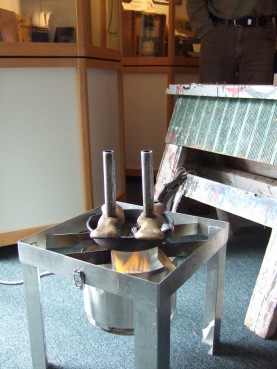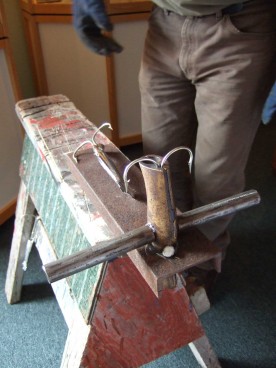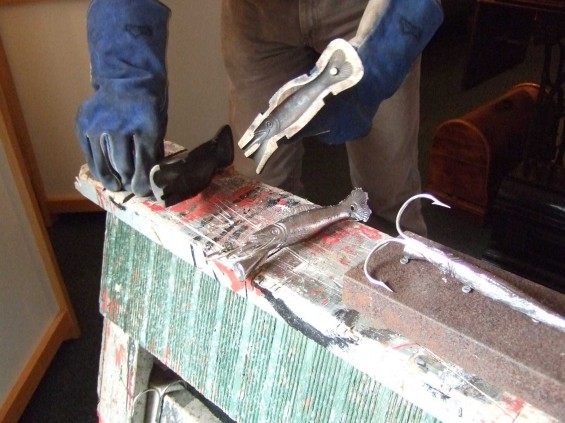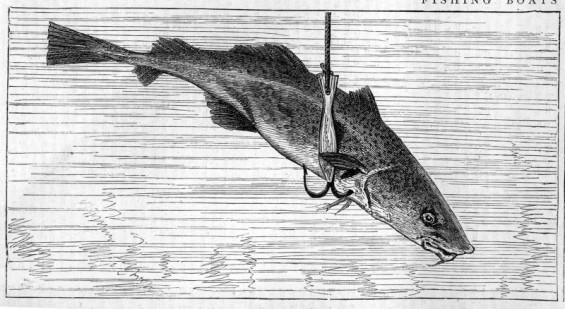ASSOCIATION FÉCAMP TERRE-NEUVE


A Port au Choix, Dean Rumbolt continue à couler des "faux" dans un moule hérité de son aïeul. En voici l'histoire rédigée par sa fille Gwyn Rumbolt en 1997, telle qu'elle lui a été racontée par son grand-père Austin Rumbolt :
" Ce moule à faux est en bronze, avec deux manches en bois. Il est approximativement âgé de 200 ans. Mon arrière-arrière grand-père, Alfred Rumbolt, se l'est procuré auprès d'un pêcheur français qui venait pour pêcher à Port au Choix à la saison d'été.
Mon arrière arrière grand-père l'utilisait pour fabriquer ses propres faux afin de pouvoir pêcher. Quand il eut fini de l'utiliser, il le transmit à son fils, Victor Rumbolt, qui est mon arrière grand-père, et qui l'a utilisé de la même manière que son père. Puis il le passa à son fils, Austin Rumbolt.
Mon grand-père Austin Rumbolt, a utilisé les faux pendant des années. Il commença à pêcher à l'âge de 12 ans, puis il vint à l'école pendant la saison d'hiver jusqu'à ses 16 ans. Après cela, il pêcha à plein temps. Il utilisait ce moule pour fabriquer des faux comme son père et son grand-père avant lui. Il partit pour travailler pour "Park Canada" en 1979. Aussi, il passa le moule à son fils Dean, qui est mon père.
Maintenant, mon père détient le moule à faux. Il fond du plomb pour le couler dans le moule. Quand le plomb refroidit et durcit, il démonte le moule et la forme apparaît comme un poisson très brillant. Le plomb qu'il utilise provient du vieux couvent de Stephenville et de l'ancien hôpital de Port Saunders ; il paye très cher pour chaque livre de plomb.
Mon père vend les faux aux pêcheurs locaux qui les utilisent pour attraper du poisson. Il en utilise aussi lui-même. Quelquefois, je vais jusqu'au magasin d'accastillage et je le regarde fondre le plomb et le couler dans le moule. C'est très intéressant à voir. Un jour, j'imagine, mon père le passera à mon frère Cameron."
Gwyn Rumbolt, 1997 (document Centre Héritage de Port-au-choix, traduction Mh. Desjardins)
clichés © MH Desjardins, Port au Choix, août 2009
" The Jigger mould is made of solid brass, with two wooden handles. It is approximately 200 years old. My great, great grandfather, Alfred Rumbolt, got it from a French fisherman who came to Port Au Choix to fish in the summer time, My great, great grandfather used to rnake jiggers so he could catch fish. When he was finished using the mould he passed it on to his son, Victor Rumbolt, who is my great grandfather. He used it the same way as his father did. He then passed it on to his son, Austin Rumbolt.
My grandfather Austin Rumbolt, used the jiggers for many years. He started fishing at the age of 12 and he went to school in the winter time until he was 16. After this, he went fishing full time. He used the mould to make jiggers like his father and grandfather before him. He went to work for Parks Canada in 1979. That's when he passed the mould to his son, Dean, who is my father.
Now my father has the Jigger mould. He melts down lead to run through the mould at the end. When the lead cools down and hardens, he takes the mould apart and it is shaped like a fish and is very shiny. The lead that he uses is from the old convent in Stephenville and the old Port Saunders hospital. He pays so much per pound of lead.
My dad sells the jiggers to local fishermen who use them to catch fish. He also uses them himself. Sometimes I go down to the fish store and watch him melt down the lead and run it in the Jigger mould. It is very interesting to watch. Someday, I guess, my dad is going to pass it down to my brother, Cameron."
Story written in 1997 by granddaughter Gwyn Rumbolt as told to her by her grandfather, Austin Rumbolt.

Qu'est-ce qu'une "faux" ?
La faux est un instrument composé de deux, trois ou quatre ains (ou hains) ou hameçons, joints ensemble par les branches, tenus ensemble par un saumon (lingot) de plomb de la forme d’un hareng constituant un leurre, gréé par un ou deux au bout d'une ligne en chanvre.
Son nom vient du mouvement que le pêcheur imprime à la ligne comparable au mouvement du faucheur. Quand le pêcheur se trouve dans un lieu où les morues abondent et nagent en bancs serrés (piaules), à faible profondeur, et qu’elles refusent l’appât dont les ains sont amorcés, il se sert de la "faux". Les morues sont gourmandes et, trompées, prennent pour un hareng le petit lingot de plomb et s’empressent de le mordre ; le pêcheur agitant continuellement sa « faux », attrape les morues par où le hasard les fait crocher.








